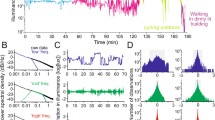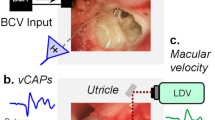Abstract
The contribution of iris muscle steady state and dynamic response characteristics to the shaping of the pupil response to light in the hooded rat were studied using electrical stimulation of the parasympathetic fibers in the III nerve. The waveforms of pupillary contractions to single or brief trains of electrical impulses applied to the III nerve were virtually identical to those elicited with short duration light flashes. Individual contractions could be resolved at stimulation rates of 2 Hz and below, and the size of the contractions increased with the decrease in frequency. The pupil responded to long trains of stimuli above 2 Hz with smooth tonic contractions. Steady state contraction amplitude was linearly related to log stimulation frequency. The mean time constant of pupil constriction to stimulus trains was 1.41 s (SD ± 0.71 s) and the shortest mean latency was 292 ms (SD ± 30 ms). The fastest mean latency of pupil constriction to the brightest light flash used was 295 ms. In contrast, the time constant of pupillary dilation was 7 s (SD ± 1.4 s) and the shortest latency was 485 ms (SD ± 74 ms). Therefore, the sluggish dynamic properties of the iris musculature are responsible for the asymmetries in pupil contraction, dilation, and latencies as well as low flicker fusion frequency and constriction amplitude characteristics of pupil responses to light.







Similar content being viewed by others
References
Blandizzi C, Doda M, Tarkovács G, Del Tacca M, Vizi ES, (1991) Functional evidence that acetylcholine release from Auerbach’s plexus of guinea-pig ileum is modulated by α2A-adrenoceptor subtype. Eur J Pharmacol 205:311–313
Breen LA, Burde RM, Loewy AD (1983) Brainstem connections to the Edinger-Westphal nucleus of the cat: a retrograde tracer study. Brain Res 261:303–306
Burde RM, Loewy AD (1980) Central origin of oculomotor parasympathetic neurons in the monkey. Brain Res 198:434–439
Cavaggioni A, Madarasz I, Zampollo A (1968) Photic reflex and pretectal region. Arch Ital Biol 106:227–242
Chan KMC, Young MJ, Lund RD (1995) Interactive events subserving the pupillary light reflex in pigmented and albino rats. Eur J Neurosci 7:2053–2063
Clarke RJ, Gamlin PDR (1995) The role of the pretectum in the pupillary light reflex (Chap. 12). In: Taylor A, Djamgoz MBA, Ikeda H (eds) Basic and clinical perspectives in vision research: a celebration of the career of Hisako Ikeda. Plenum Press, New York, pp 149–159
Clarke RJ, Ikeda H (1981) Pupillary response and luminance and darkness detector neurons in the pretectum of the rat. In: Maffei L (ed) Pathophysiology of the visual system, Documenta ophthalmologica. Proceedings series. W. Junk, The Hague, vol 30, pp 53–61
Clarke RJ, Ikeda H (1985a) Luminance and darkness detectors in the olivary and posterior pretectal nuclei and their relationship to the pupillary light reflex in the rat. I. Studies with steady luminance levels. Exp Brain Res 57:224–232
Clarke RJ, Ikeda H (1985b) Luminance detectors in the olivary pretectal nucleus and their relationship to the pupillary light reflex in the rat, II. Studies using sinusoidal light. Exp Brain Res 59:83–90
Clarke RJ, Zhang H, Gamlin PDR (2003) Primate pupillary light reflex: receptive field characteristics of pretectal luminance neurons. J Neurophysiol 89:3168–3178
Distler C, Hoffmann K-P (1989) The pupillary light reflex in normal and innate microstrabismic cats, I: Behavior and receptive-field analysis in the nucleus praetectalis olivaris. Vision Neurosci 3:127–138
Gamlin PDR (2000) The functions of the Edinger–Westphal nucleus. In: Burnstock G, Sillito A (eds) Nervous control of the eye. Harwood Academic Publishers, Switzerland, pp 117–154
Gamlin PDR, Clarke RJ (1996) Dynamics of the pupillary light reflex in the alert rhesus monkey: parasympathetic and sympathetic components. Invest Ophthal Vis Sci 15(Suppl):691
Gamlin PDR, Peterson BB, Dacey DM (2001) Physiology and morphology of retinal ganglion cells projecting to the pretectal olivary nucleus of the rhesus monkey. Invest Ophth Vis Sci 42(Suppl):676
Gamlin PD, Zhang Y, Clendaniel RA, Mays LE (1994) Behavior of identified Edinger-Westphal neurons during ocular accommodation. J Neurophysiol 72:2368–2382
Gamlin PDR, Zhang H, Clarke RJ (1995) Luminance neurons in the pretectal olivary nucleus mediate the pupillary light reflex in the rhesus monkey. Exp Brain Res 106:177–180
Gordon AR, Siegman MJ (1971a) Mechanical properties of smooth muscle. I. Length-tension and force-velocity relations. Am J Physiol 221:1243–1249
Gordon AR, Siegman MJ (1971b) Mechanical properties of smooth muscle. II. Active state. Am J Physiol 221:1250–1254
Grozdanic S, Sakaguchi DS, Kwon YH, Kardon RH, Sonea IM (2002) Characterization of the pupil light reflex, electroretinogram and tonometric parameters in healthy rat eyes. Curr Eye Res 25:69–78
Grozdanic SD, Sakaguchi DS, Kwon YH, Kardon RH, Sonea IM (2003) Functional characterization of retina and optic nerve after acute ocular ischemia in rats. Invest Ophthalmol Vis Sci 44:2597–2605
Ishikawa H, Mitsui Y, Yoshitomi T, Mashimo K, Aoki S, Mukuno K, Shimizu K (2000) Presynaptic effects of botulinum toxin type A on the neuronally evoked response of albino and pigmented rabbit iris sphincter and dilator muscles. Japan J Ophthalmol 44:106–109
Jewell BR, Wilkie DR (1960) The mechanical properties of relaxing muscle. J Physiol 152:30–47
Krenz WC, Stark L (1985) Systems model for pupil size effect. II. Feedback model. Biol Cybern 51:391–397
Krivoshik AP, Barr L (2000) Force relaxes before the fall of cytosolic calcium in the photomechanical response of rat sphincter pupillae. Am J Physiol Cell Physiol 279:274–280
Loewenfeld IE (1993) The pupil. Anatomy, physiology, and clinical applications, vol I. Iowa State University Press, Ames
Loewenfeld IE, Newsome DA (1971) Iris mechanics. I. Influence of pupil size on dynamics of pupillary movements. Am J Ophthalmol 71:347–362
Magoun HW, Atlas D, Hare WK, Ranson SW (1935) The afferent pathways of the pupillary light reflex in the monkey. Brain 59:234–249
Ohba N, Alpern M (1972) Adaptation of the pupil light reflex. Vision Res 12:953–967
Paxinos G, Watson C (1998) The rat brain in stereotaxic coordinates, 4th edn. Elsevier Academic Press, London
Pong M, Fuchs AF (2000) Characteristics of the pupillary light reflex in the macaque monkey: discharge patterns of pretectal neurons. J Neurophysiol 84:964–974
Ranson RJ, Magoun HW (1933) The central path of the pupilloconstrictor reflex in response to light. Arch Neurol Psychiat 30:1193–1202
Sillito AM, Zbrozyna AW (1970) The activity characteristics of the preganglionic pupilloconstrictor neurones. J Physiol 211:767–779
Smeraski CA, Sollars PJ, Ogilvie MD, Enquist LW, Pickard GE (2004) Suprachiasmatic nucleus input to autonomic circuits identified by retrograde transynaptic transport of pseudorabies virus from the eye. J Comp neurol 471:298–313
Smith JD, Ichinose LY, Masek GA, Watanabe T, Stark L (1968) Midbrain single units correlating with pupil response to light. Science 162:1302–1303
Smith JD, Masek GA, Ichinose LY, Watanabe T, Stark L (1970) Single neuron activity in the pupillary system. Brain Res 24:219–234
Strassman A, Mason P, Eckenstein F, Baughman RW, Maciewicz R (1987) Choline acetyltransferase immunocytochemistry of Edinger–Westphal and ciliary ganglion afferent neurons in the cat. Brain Res 423:293–304
Sun F, Stark L (1983) Pupillary escape intensified by large pupillary size. Vision Res 23:611–615
Sun F, Tauchi P, Stark L (1983) Dynamic pupillary response controlled by the pupil size effect. Exp Neurol 82:313–324
Terdiman J, Smith JD, Stark L (1969) Pupil response to light and electrical stimulation: static and dynamic characteristics. Brain Res 16:288–292
Toda M, Okamura T, Fujimiya M, Azuma I, Toda N (1999) Mechanisms underlying the neurogenic relaxation of isolated porcine sphincter pupillae. Exp Eye Res 68:505–512
Trejo LT, Cicereone CM (1984) Cells in the pretectal olivary nucleus are in the pathway for the direct light reflex of the pupil in the rat. Brain Res 300:49–62
Usui S, Hirata Y (1995) Estimation of autonomic nervous activity using the inverse dynamic model of the pupil muscle plant. Ann Biomed Eng 23:375–387
Usui S, Stark L (1978) Sensory and motor mechanisms interact to control amplitude of pupil noise. Vision Res 18:505–507
Yamaji K, Yoshitomi T, Usui S, Ohnishi Y (2003) Mechanical properties of the rabbit iris smooth muscles. Vision Res 43:479–487
Young ML, Lund RD (1994) The anatomical substrate subserving the pupillary light reflex in rats: origin of the consensual pupillary response. Neuroscience 62:481–496
Zhang H, Clarke RJ, Gamlin PDR (1996) Behavior of luminance neurons in the pretectal olivary nucleus during the pupillary near response. Exp Brain Res 112:158–162
Acknowledgments
I would like to thank Dr Michael Brimacombe of the department of Biostatistics and Preventive Medicine, UMDNJ, Newark NJ for help with the statistical analysis. This research is funded in part by the Fight Blindness USA Foundation.
Author information
Authors and Affiliations
Corresponding author
Rights and permissions
About this article
Cite this article
Clarke, R.J. Shaping the pupil’s response to light in the hooded rat. Exp Brain Res 176, 641–651 (2007). https://doi.org/10.1007/s00221-006-0649-6
Received:
Accepted:
Published:
Issue Date:
DOI: https://doi.org/10.1007/s00221-006-0649-6




